Note: This novel was LONGLISTED for the Man Booker Prize of 2012.
“A critic friend of mine says that deciding between English fiction and American fiction is like deciding between dinner with a corpse and cocktails with a baby; but at least the baby has a life ahead of it.”—Rackenham, to Adele Hitler
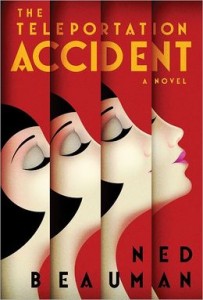 By this definition, English author Ned Beauman’s The Teleportation Accident should be dull, if not moribund, reading. Instead, it is the wackiest book I have read in ages – maybe ever. The response of Beauman’s main character, Egon Loeser, a Berliner, to this bold statement about English vs. US culture shows his own opinion: “If you want to understand what American culture really is you should go look at the new escalators [at the department store]…Never in your life will you have seen so many apparently healthy adults queueing up for the privilege of standing still.” Later one character refers to the style of an American novel as having “a vocabulary about the size of a budgerigar’s [but also having] a strangely poetic way with the grease-stained American vernacular.”
By this definition, English author Ned Beauman’s The Teleportation Accident should be dull, if not moribund, reading. Instead, it is the wackiest book I have read in ages – maybe ever. The response of Beauman’s main character, Egon Loeser, a Berliner, to this bold statement about English vs. US culture shows his own opinion: “If you want to understand what American culture really is you should go look at the new escalators [at the department store]…Never in your life will you have seen so many apparently healthy adults queueing up for the privilege of standing still.” Later one character refers to the style of an American novel as having “a vocabulary about the size of a budgerigar’s [but also having] a strangely poetic way with the grease-stained American vernacular.”
 Despite its title, this novel is clearly not going to be science fiction. Instead it is a wide-ranging novel about just about anything that comes into the author’s head, told in glorious and inglorious imagery throughout. Though it is set almost entirely between 1931 and 1939 and does trace the idea of teleportation as a motif throughout the novel, it is really the story of Egon Loeser, a young set designer at the Allien Theatre in Berlin who is determined to do something spectacular with his life. A proponent of the New Expressionist theatre as a reaction to realism, Loeser is, quite frankly, the “loser” that his name suggests, almost totally lacking success in the area of paramount importance to him – sex. He sometimes thinks he is in love and he seeks love constantly, to the exclusion of nearly every other aspect of his life, but he remains frustrated.
Despite its title, this novel is clearly not going to be science fiction. Instead it is a wide-ranging novel about just about anything that comes into the author’s head, told in glorious and inglorious imagery throughout. Though it is set almost entirely between 1931 and 1939 and does trace the idea of teleportation as a motif throughout the novel, it is really the story of Egon Loeser, a young set designer at the Allien Theatre in Berlin who is determined to do something spectacular with his life. A proponent of the New Expressionist theatre as a reaction to realism, Loeser is, quite frankly, the “loser” that his name suggests, almost totally lacking success in the area of paramount importance to him – sex. He sometimes thinks he is in love and he seeks love constantly, to the exclusion of nearly every other aspect of his life, but he remains frustrated.
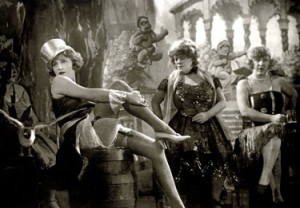
The Blue Angel, starring Marlene Dietrich, produced in Germany in 1930.
At the theatre, he is working on a production about Adriano Lavicini, the man who developed and used a Teleportation Device during a stage production in Paris in 1679. Lavicini’s device was spectacular when it was used, ultimately causing the entire theatre to crumble, and leaving twenty-five dead in the collapse and ensuing fire. Loeser’s Teleportation Device, by contrast, is not dramatic enough to cause any real damage during the one performance in which it is used, except for the dislocation of an actor’s arms. Suspended above the stage, the actor resembles “large pallid male genitalia painfully mispositioned in an athlete’s thong.”
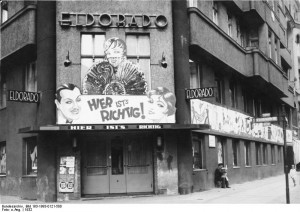
The Eldorado Nightclub, 1933, before Hermann Goering turned it into a Nazi headquarters
The idea that one might escape time and place through a Teleportation Device seems irrelevant to the literary and theatre crowd with which Loeser associates. The Depression is a major factor in the life of Weimar Germany in 1931, though “This so-called Depression makes no difference to us…Six million jobless doesn’t seem like so many when none of us ever had any wish for a real job in the first place.” Likewise, little notice is made when Loeser meets “Adele Hitler,” except to note that she is “no relation” to another Hitler. Loeser had tutored her two years before, when she was a young schoolgirl, but she has now returned from Switzerland. Loeser falls instantly in love – again.
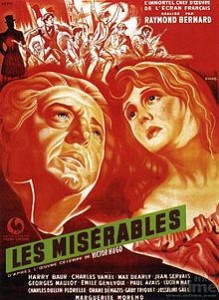
Les Miserables, filmed in Paris in 1934.
Two years later, “even the most heedless and egotistical Berliner couldn’t help but notice that something nasty was going on. At parties now, optimism had given way to dread, and yells to whispers.” The drug ketamine, a “blackmarket horse tranquilizer” has now replaced cocaine, but Loeser does not enjoy it. “If I want to feel as if I’m being sucked down a fathomless gloomy tunnel for hours and hours then I have a complete set of Schopenhauer at home.” A Nazi book burning is excused because it destroys “degenerate literature.” Loeser, who is depressed because Adele has insulted him, observes it as “some sort of silly art performance,” and gets into the act, throwing books by Brecht, Kafka, Trotsky, and Zola onto the pyre. He eventually decides to go to Paris, where Adele is reported to be.
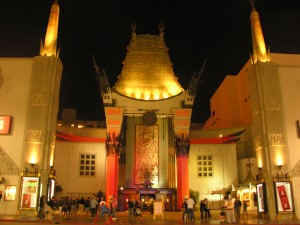
Grauman’s Chinese Theatre opened in Los Angeles in 1927, and has a brief part in this novel.
As the novel jumps wildly around in time and place, Loeser becomes involved in a series of crazy escapades which often have their own individual charms. In Paris, he joins a charlatan who preys on wealthy women and promises to make them look younger through the surgical implantation of monkey glands, for which the two find a unique substitute, revealed only when the pet iguana of one of the women decides to take matters into his own paws. In Los Angeles, to which the entire German theatre world seems to have repaired after Paris, Loeser becomes a director, in addition to being a set designer. There, too, he falls in love: “[Mildred] was the perfect negation of the city in which she’d been born, a pearlescent kidney stone that California had grown in its own gut, one shake of her head enough to shame a million nodding, nodding, nodding oil derricks.”
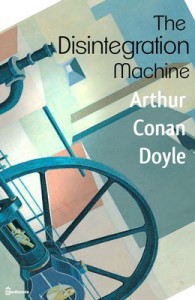
The Disintegration Machine by Sir Arthur Conan Doyle, first published in 1929
The action continues and continues, ricocheting around through time and space, incorporating vivid stories about Lavicini, about Loeser’s search for his favorite pornographic book (now lost), and about Adele and her infidelities. Characters are killed and disemboweled, their hearts removed; and ghosts appear and reappear, with one character breeding ghosts for use in a machine which they will power. Virtually everyone gets blackmailed about an assortment of crimes, and one character stays busy selling the skeletons of Troodonians, early men who evolved from dinosaurs, with scaly skin and serrated teeth. Throughout all this, the search for the key to a Teleportation Device continues.
If you are wondering how all this action connects, it doesn’t. Beauman seems to have taken literary expressionism to newer and more modern levels here, writing whatever crosses his mind, using repeating characters to provide some kind of connection through time as episodes unfold, often with dramatic results, but sometimes leaving the reader (at least this reader) way behind. Fortunately, his descriptive talents and his wild humor will be enough to keep many readers going, even when they are not 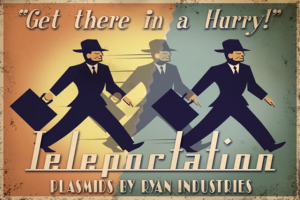 sure in what direction they are headed or why. Four endings from four different time periods give the reader a choice. Choose one or all, whatever you like, the author seems to say. This novel is unique, one requiring a good deal of patience, and even fortitude, at least for some of us who are significantly older than the twenty-seven-year-old author.
sure in what direction they are headed or why. Four endings from four different time periods give the reader a choice. Choose one or all, whatever you like, the author seems to say. This novel is unique, one requiring a good deal of patience, and even fortitude, at least for some of us who are significantly older than the twenty-seven-year-old author.
Photos, in order: The author’s photo is from http://www.3ammagazine.com
The Blue Angel, with Marlene Dietrich, 1930, is found on http://dryden.eastmanhouse.org
The Eldorado nightclub was closed by Hermann Goering in 1933 and turned into a Nazi headquarters. See
http://www.cabaret-berlin.com
Les Miserables, filmed in Paris, in 1934. This poster is from http://en.wikipedia.org
Grauman’s Chinese Theatre opened in 1927, with its famous Walk of Fame: http://www.preservation.lacity.org
Sir Arthur Conan Doyle was always interested in the paranormal. He published “The Disintegration Machine” in a magazine in 1929. Photo from http://www.feedbooks.com
An advertisement for teleportation is from http://bioshock.wikia.com
ARC: Bloomsbury USA
